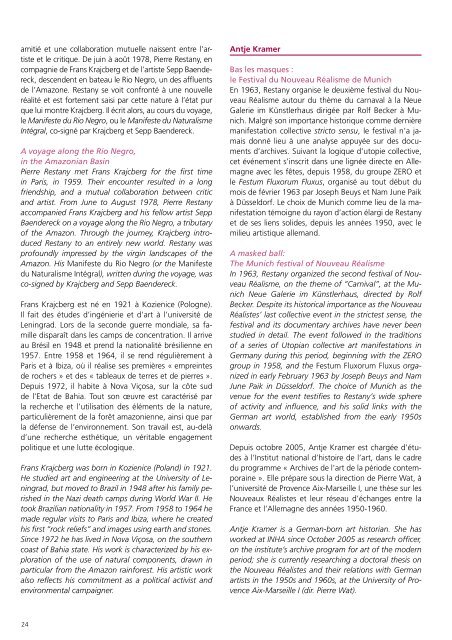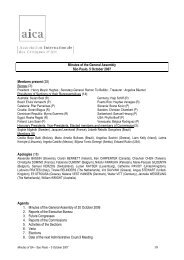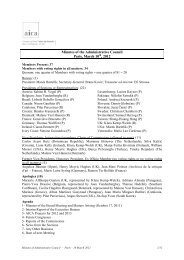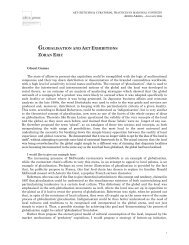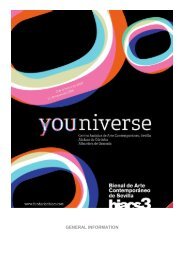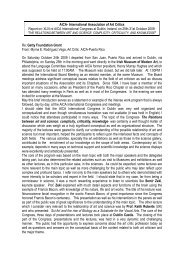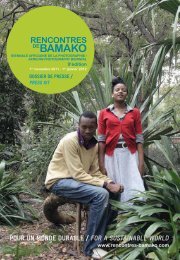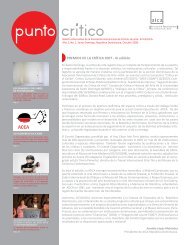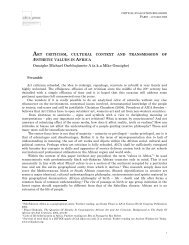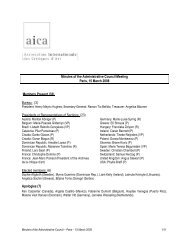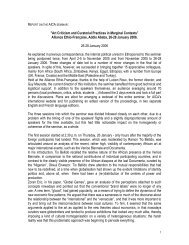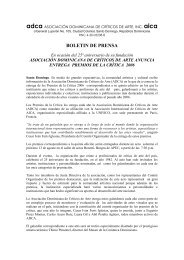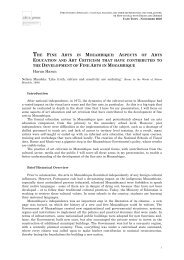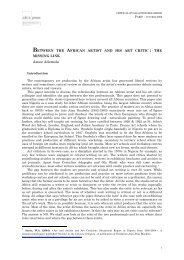Pierre Restany Pierre Restany's - AICA international
Pierre Restany Pierre Restany's - AICA international
Pierre Restany Pierre Restany's - AICA international
You also want an ePaper? Increase the reach of your titles
YUMPU automatically turns print PDFs into web optimized ePapers that Google loves.
amitié et une collaboration mutuelle naissent entre l’artiste<br />
et le critique. De juin à août 1978, <strong>Pierre</strong> <strong>Restany</strong>, en<br />
compagnie de Frans Krajcberg et de l’artiste Sepp Baendereck,<br />
descendent en bateau le Rio Negro, un des affluents<br />
de l’Amazone. <strong>Restany</strong> se voit confronté à une nouvelle<br />
réalité et est fortement saisi par cette nature à l’état pur<br />
que lui montre Krajcberg. Il écrit alors, au cours du voyage,<br />
le Manifeste du Rio Negro, ou le Manifeste du Naturalisme<br />
Intégral, co-signé par Krajcberg et Sepp Baendereck.<br />
A voyage along the Rio Negro,<br />
in the Amazonian Basin<br />
<strong>Pierre</strong> <strong>Restany</strong> met Frans Krajcberg for the first time<br />
in Paris, in 1959. Their encounter resulted in a long<br />
friendship, and a mutual collaboration between critic<br />
and artist. From June to August 1978, <strong>Pierre</strong> <strong>Restany</strong><br />
accompanied Frans Krajcberg and his fellow artist Sepp<br />
Baendereck on a voyage along the Rio Negro, a tributary<br />
of the Amazon. Through the journey, Krajcberg introduced<br />
<strong>Restany</strong> to an entirely new world. <strong>Restany</strong> was<br />
profoundly impressed by the virgin landscapes of the<br />
Amazon. His Manifeste du Rio Negro (or the Manifeste<br />
du Naturalisme Intégral), written during the voyage, was<br />
co-signed by Krajcberg and Sepp Baendereck.<br />
Frans Krajcberg est né en 1921 à Kozienice (Pologne).<br />
Il fait des études d’ingénierie et d’art à l’université de<br />
Leningrad. Lors de la seconde guerre mondiale, sa famille<br />
disparaît dans les camps de concentration. Il arrive<br />
au Brésil en 1948 et prend la nationalité brésilienne en<br />
1957. Entre 1958 et 1964, il se rend régulièrement à<br />
Paris et à Ibiza, où il réalise ses premières « empreintes<br />
de rochers » et des « tableaux de terres et de pierres ».<br />
Depuis 1972, il habite à Nova Viçosa, sur la côte sud<br />
de l’Etat de Bahia. Tout son œuvre est caractérisé par<br />
la recherche et l’utilisation des éléments de la nature,<br />
particulièrement de la forêt amazonienne, ainsi que par<br />
la défense de l’environnement. Son travail est, au-delà<br />
d’une recherche esthétique, un véritable engagement<br />
politique et une lutte écologique.<br />
Frans Krajcberg was born in Kozienice (Poland) in 1921.<br />
He studied art and engineering at the University of Leningrad,<br />
but moved to Brazil in 1948 after his family perished<br />
in the Nazi death camps during World War II. He<br />
took Brazilian nationality in 1957. From 1958 to 1964 he<br />
made regular visits to Paris and Ibiza, where he created<br />
his first “rock reliefs” and images using earth and stones.<br />
Since 1972 he has lived in Nova Viçosa, on the southern<br />
coast of Bahia state. His work is characterized by his exploration<br />
of the use of natural components, drawn in<br />
particular from the Amazon rainforest. His artistic work<br />
also reflects his commitment as a political activist and<br />
environmental campaigner.<br />
Antje Kramer<br />
Bas les masques :<br />
le Festival du Nouveau Réalisme de Munich<br />
En 1963, <strong>Restany</strong> organise le deuxième festival du Nouveau<br />
Réalisme autour du thème du carnaval à la Neue<br />
Galerie im Künstlerhaus dirigée par Rolf Becker à Munich.<br />
Malgré son importance historique comme dernière<br />
manifestation collective stricto sensu, le festival n’a jamais<br />
donné lieu à une analyse appuyée sur des documents<br />
d’archives. Suivant la logique d’utopie collective,<br />
cet événement s’inscrit dans une lignée directe en Allemagne<br />
avec les fêtes, depuis 1958, du groupe ZERO et<br />
le Festum Fluxorum Fluxus, organisé au tout début du<br />
mois de février 1963 par Joseph Beuys et Nam June Paik<br />
à Düsseldorf. Le choix de Munich comme lieu de la manifestation<br />
témoigne du rayon d’action élargi de <strong>Restany</strong><br />
et de ses liens solides, depuis les années 1950, avec le<br />
milieu artistique allemand.<br />
A masked ball:<br />
The Munich festival of Nouveau Réalisme<br />
In 1963, <strong>Restany</strong> organized the second festival of Nouveau<br />
Réalisme, on the theme of “Carnival”, at the Munich<br />
Neue Galerie im Künstlerhaus, directed by Rolf<br />
Becker. Despite its historical importance as the Nouveau<br />
Réalistes’ last collective event in the strictest sense, the<br />
festival and its documentary archives have never been<br />
studied in detail. The event followed in the traditions<br />
of a series of Utopian collective art manifestations in<br />
Germany during this period, beginning with the ZERO<br />
group in 1958, and the Festum Fluxorum Fluxus organized<br />
in early February 1963 by Joseph Beuys and Nam<br />
June Paik in Düsseldorf. The choice of Munich as the<br />
venue for the event testifies to <strong>Restany</strong>’s wide sphere<br />
of activity and influence, and his solid links with the<br />
German art world, established from the early 1950s<br />
onwards.<br />
Depuis octobre 2005, Antje Kramer est chargée d’études<br />
à l’Institut national d’histoire de l’art, dans le cadre<br />
du programme « Archives de l’art de la période contemporaine<br />
». Elle prépare sous la direction de <strong>Pierre</strong> Wat, à<br />
l’université de Provence Aix-Marseille I, une thèse sur les<br />
Nouveaux Réalistes et leur réseau d’échanges entre la<br />
France et l’Allemagne des années 1950-1960.<br />
Antje Kramer is a German-born art historian. She has<br />
worked at INHA since October 2005 as research officer,<br />
on the institute’s archive program for art of the modern<br />
period; she is currently researching a doctoral thesis on<br />
the Nouveau Réalistes and their relations with German<br />
artists in the 1950s and 1960s, at the University of Provence<br />
Aix-Marseille I (dir. <strong>Pierre</strong> Wat).<br />
24


